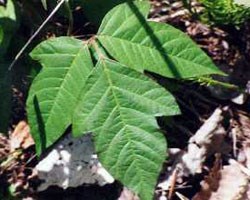
Photo by Jennifer Anderson @ USDA-NRCS PLANTS Database Although uncommon, poison ivy can be found throughout Acadia. Here is some information, adapted from the Shenandoah National Park website, to help you learn to identify and avoid it while exploring the park. Scientific name: Toxicodendron radicans (previously called Rhus radicans) Description Poison ivy fruit is round, smooth, approximately 3/16 inch in diameter, pale green to grayish white in color, and clustered. The fruit matures from August through October and persists. Flowers grow in small branching clusters in the axils, are yellowish to greenish and approximately 1/8 inch in diameter, and bloom from June through July. Poison ivy grows as a shrub or vine. Shrubs can grow erect and bushy. The woody vine can trail, straggle, or scramble over rocks. It can climb high due to aerial rootlets on its stems and attain a 15-cm diameter to its trunk. These climbing vines have fibrous, hair-like rootlets that attach to tree bark or other objects and look like fuzzy ropes. Habitat Poison ivy is a pioneer species, growing and reproducing quickly using large amounts of sunlight from open areas such as old fields and forest gaps. A hurricane, death of a large tree, fire, or other disturbance can cause such forest gaps, or openings, which let a lot of light in. Therefore, likely locations include wooded areas, thickets, roadsides, clearings, fence rows, and meadows. Poison ivy is moderately shade tolerant, however full sunlight in such areas encourages lush, dense growth. Poison ivy can also be found on dunes of coastal areas, above the rocky shore, and in open, sunny areas such as along roadsides and trails. Poison Ivy and Wildlife Small bees and flies pollinate the flowers in the spring. Insects feed on the plant, and caterpillars from moths feed on the leaves. Larval insects spin silk to roll and fold the leaves of poison ivy over to enclose them for the pupa stage. Poison Ivy and People Wet compresses, taking a cool bath, and applying calamine lotion will help sooth the rash. Treatment by a health professional may be necessary if the rash is moderate or severe, or if infection occurs. To help prevent infection avoid scratching the rash. To prevent exposure while visiting Acadia National Park, it is important to be able to recognize poison ivy. Be alert to the many forms of poison ivy. Avoid all plants, bushes, and climbing vines with three leaves that may have smooth or rough edges, which may be shiny or dull in appearance. It is also important to remember that even though the plant is dormant in the winter, with only sticks and roots, it still contains the same amount of urushiol as in the summertime. Do not touch these plants, or make contact with them with your clothing, hat, or backpack. Long pants, enclosed shoes, long sleeves, and vinyl gloves can help create a barrier between the plant and your skin. If your skin has been touched by poison ivy, wash it immediately with water. The sooner you can do this the better; however, you may still be able to wash your skin up to four hours after contact, which may help prevent your skin from breaking out later with a rash. When you get home, carefully put your clothes in the washer, while avoiding touching the clothing parts that may have the plant oil on them. Have a great visit to the park and stay poison ivy free! References Gleason, Henry A.1952. Illustrated Flora of the Northeastern United States and Adjacent Canada. Vol. 2, Hafner Press, New York. pp. 494-5. Grimm, William Carey. 1993. The Illustrated Book of Wildflowers and Shrubs. Stackpole Books, Mechanicsburg, Pennsylvania. pp. 484-5. Kricher, John C., and Gordon Morrison. 1988. Eastern Forests, Peterson Field Guides. Houghton Mifflin Company, Boston, Massachusetts. pp. 21, 23-4, 61, 79, 100, 132-3, 226-7, 249-50. Newcomb, Lawrence. 1977. Newcomb’s Wildflower Guide. Little, Brown and Co., Boston, Massachusetts. pp. 330-1. Petrides, George A.1972. A Field Guide to Trees and Shrubs, Peterson Field Guides. Houghton Mifflin Company, Boston, Massachusetts. pp. 130-1, 154-5. Radford, Albert E., Harry E. Ahles, and C. Ritchie Bell. 1968. Manual of the Vascular Flora of the Carolinas. The University of North Carolina Press, Chapel Hill, North Carolina. pp. 676-7. Strausbaugh, P.D., and Earl L. Core. Flora of West Virginia. Seneca Books, Inc., Morgantown, West Virginia. pp. 606, 608-9. Links |
Last updated: April 12, 2022
